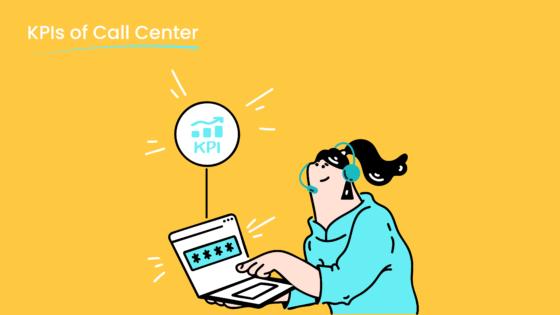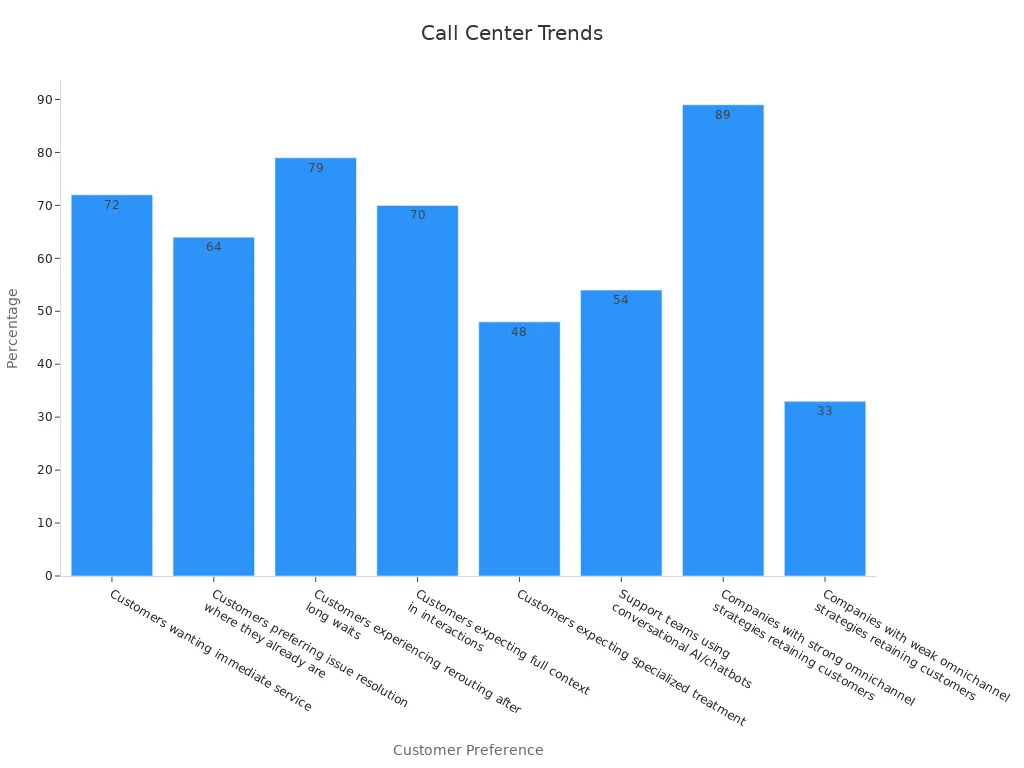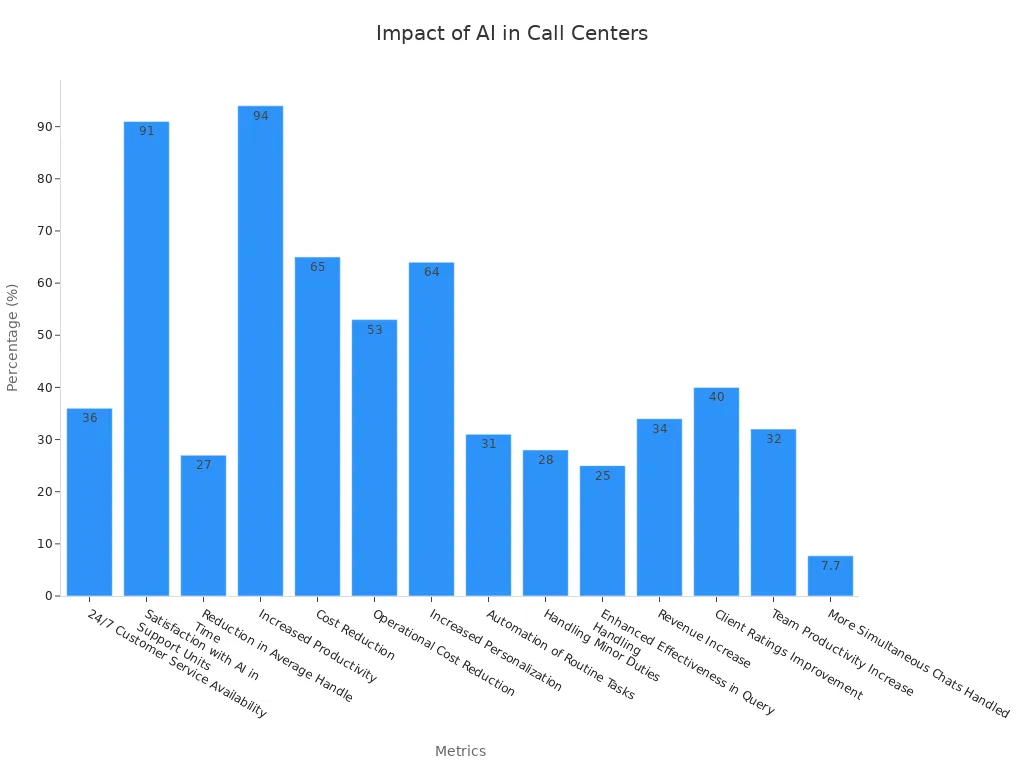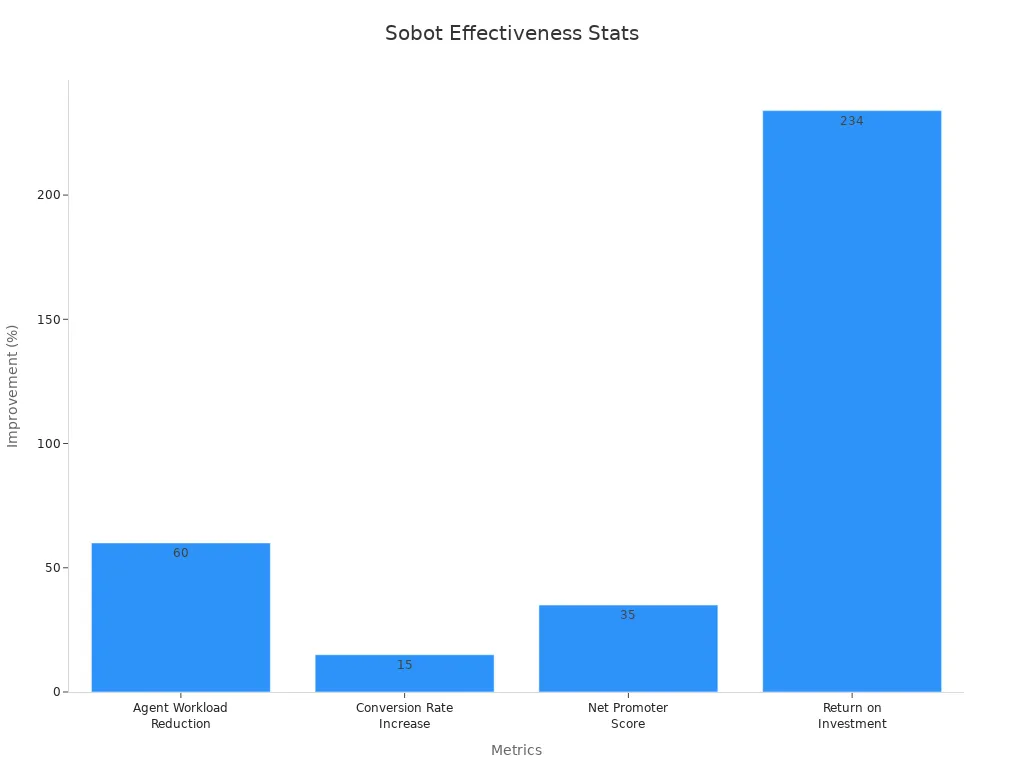What the Numbers Say About Trends in Call Center Industry

The average cost per customer service call ranges from $2.70 to $5.60, with agent salaries making up as much as 70% of this total. Data-driven decisions help companies manage these costs and improve agent scheduling, training, and routing. Recent call center statistics show that 71% of consumers expect personalized interactions, highlighting a major shift in the industry. As customer expectations change, trends in call center industry operations reveal a growing need for actionable insights. Sobot, a leader in AI-powered customer contact solutions, uses Sobot AI to help businesses boost efficiency and deliver better customer experience. These industry trends prove that accurate statistics and analytics unlock new ways to improve customer service and overall experience.
The global call center analytics market is expected to reach $2.62 billion by 2025, showing how much the industry values insights for better customer service and operational outcomes. (source)
Industry Trends Overview
The call center industry is changing quickly. New technology, digital tools, and higher customer expectations shape the way companies deliver customer service. Recent call center statistics show that digital transformation, automation, and omnichannel customer engagement are now essential for success. Companies use these trends to improve customer experience and stay competitive in the industry.
Key Shifts in Customer Expectations
Customers today want fast, easy, and personal service. Many feel tired or stressed after support calls. According to recent statistics, 52% of consumers feel exhausted by support interactions, and 55% feel stressed. Over half of customers expect companies to use their data to personalize the experience. In fact, 59% believe businesses should personalize experiences based on collected data.
Customers also want quick answers. About 65% expect instant responses when they contact a brand. Many get frustrated if they have to repeat information. Statistics show that 56% of customers have to re-explain their issues to different representatives. This leads to poor customer experience and can cause customers to switch to other brands. In fact, 73% are more likely to switch after multiple negative experiences.
Note: 70% of customers expect any representative to know the full context of their conversation. This means companies must use tools that keep all customer data in one place.
Sobot helps businesses meet these expectations. Its unified workspace and AI-powered tools give agents easy access to customer data. This makes it easier to provide fast, personalized service and improve customer satisfaction.
Omnichannel and Digital Adoption
Omnichannel customer engagement is now a standard in the industry. Customers want to connect with brands through many channels, such as phone, live chat, email, social media, and messaging apps. Recent call center statistics show that 25% of support requests come from social media, and 38% use live chat or text messaging. Companies with strong omnichannel strategies see better results, including higher order values and increased customer loyalty.
Market forecasts predict that omnichannel engagement will generate $17.92 billion in revenue by 2030. This growth comes from customers wanting seamless and personalized experiences across all channels. Companies that use omnichannel solutions report a 10% year-over-year growth and a 25% increase in close rates. About 71% of companies using digital omnichannel platforms see a 9% reduction in cost per assisted contact.
Sobot’s omnichannel solution lets businesses manage all customer interactions in one place. Agents can switch between channels without losing context, which improves the customer experience. Sobot also uses AI and automation to handle routine tasks, freeing agents to focus on complex issues. This digital adoption helps companies save costs, reduce missed calls, and improve operational efficiency.
| Metric Type | Impact After Digital Adoption |
|---|---|
| Customer Satisfaction (CSAT) | 15-20% increase |
| Net Promoter Score (NPS) | 10-15 points higher |
| Customer Effort Score (CES) | 25-30% reduction |
| Problem Resolution Time | 35-50% faster |
| Digital Channel Adoption | 30-40% higher |
Digital transformation also supports remote and hybrid work. Many call centers now use cloud-based platforms. About 90% of firms rely on cloud technology for flexibility and connectivity. Sobot’s cloud call center offers high uptime and global reach, making it easy for businesses to scale and support customers worldwide.
These trends in call center industry show that companies must use digital tools and omnichannel customer engagement to meet rising expectations. By adopting solutions like Sobot, businesses can improve customer service, boost satisfaction, and stay ahead in the industry.
Call Center Statistics Insights

Customer Satisfaction and Loyalty
Call center statistics show that customer satisfaction remains a top priority for businesses. Companies use several customer satisfaction metrics to measure how well they meet customer needs. The most common metrics include Customer Satisfaction Score (CSAT), Net Promoter Score (NPS), and First Call Resolution (FCR). These statistics help leaders understand the quality of their customer service and find ways to improve.
| Metric | Latest Value / Benchmark | Interpretation / Notes |
|---|---|---|
| Net Promoter Score (NPS) | 45 | Indicates positive customer loyalty trends |
| Customer Satisfaction (CSAT) | 85% or higher (Apple >95%) | Reflects high customer satisfaction levels |
| Customer Effort Score (CES) | ~4.0 out of 5 | Customers find it relatively easy to resolve issues |
| First Contact Resolution (FCR) | 78-80% | Efficient resolution on first call |
| Average Speed of Answer (ASA) | 12 seconds | Reduced waiting time, faster customer service |
| Average Call Time | 4 minutes 15 seconds | Reflects agent efficiency in handling calls |
Companies with a CSAT of 85% or higher often see stronger customer loyalty and better customer service quality. NPS scores above 45 signal that customers are likely to recommend the brand to others.
Customer satisfaction metrics like CSAT and NPS give a clear picture of the customer service experience. CSAT measures how happy customers feel after an interaction. NPS shows how likely customers are to recommend the company. FCR tracks how many issues agents solve on the first call, which improves satisfaction and reduces repeat contacts.
Sobot helps brands like OPPO achieve high customer satisfaction and loyalty. OPPO used Sobot’s AI-powered chatbot and ticketing system to handle more requests and answer questions faster. This led to an 83% chatbot resolution rate and a 94% positive feedback rate. OPPO also saw a 57% increase in repurchase rate, showing that better customer service leads to higher loyalty. Sobot’s unified workspace and analytics tools help agents resolve issues quickly, which boosts customer satisfaction scores and NPS.
Channel Preferences and Usage
Recent call center statistics reveal that customers want fast, easy service on their preferred channels. Many customers now use live chat, social media, and messaging apps instead of only calling. Statistics show that 72% of customers want immediate service, and 64% prefer to solve issues where they already are, such as on a website or app.
| Customer Preference / Trend | Statistic | Source |
|---|---|---|
| Customers wanting immediate service | 72% | Zendesk CX Trends Report 2023 |
| Customers preferring issue resolution where they already are | 64% | Zendesk CX Trends Report 2023 |
| Customers experiencing rerouting after long waits | 79% | WiserNotify 2025 Data |
| Customers expecting full context in interactions | 70% | Zendesk CX Trends Report 2023 |
| Customers expecting specialized treatment | 48% | Accenture |
| Support teams using conversational AI/chatbots | 54% | Gartner |
| Predicted organizations using chatbots as primary channel by 2027 | ~25% | Gartner |
| Companies with strong omnichannel strategies retaining customers | 89% | Aberdeen Group via WiserNotify |
| Companies with weak omnichannel strategies retaining customers | 33% | Aberdeen Group via WiserNotify |

Companies with strong omnichannel strategies keep 89% of their customers, while those with weak strategies keep only 33%. These statistics highlight the importance of meeting customers on their chosen channels. Many customers get frustrated when they must repeat information or wait too long. About 79% of customers experience rerouting after long waits, which lowers satisfaction.
Sobot’s omnichannel solution allows agents to manage all customer interactions in one place. This unified workspace gives agents the full context of each conversation, so customers do not need to repeat themselves. Sobot’s AI-powered tools also help automate routine tasks, making the customer service experience smoother and faster. By using Sobot, companies can improve customer satisfaction, increase loyalty, and deliver better customer service across every channel.
Agent Performance and Workforce
Turnover and Retention
Employee turnover remains a major challenge in the call center industry. Recent call center statistics show that turnover rates can range from 15% to 40%, depending on the type of center and work environment. The average tenure for call center employees is about 14.3 months, with sales roles lasting slightly longer than customer support roles. High turnover leads to increased hiring and training costs, which can disrupt operations and lower service quality.
Several factors influence retention in the call center industry:
- Agents value meaningful work and a sense of accomplishment.
- Supportive and collaborative workplaces help keep agents engaged.
- Clear communication and recognition boost morale.
- Career growth and training opportunities encourage agents to stay.
- Fair pay and flexible schedules improve job satisfaction.
- Access to modern technology, like Sobot’s unified workspace, makes work more efficient.
Over half (55%) of frontline contact center workers considered quitting in the past year. Companies that invest in career progression for agents see 23% more strategic goals achieved and 15% lower attrition rates.
A stable workforce improves customer experience. Lower turnover means agents build stronger skills and relationships with customers. Companies use metrics like agent tenure, job satisfaction, and Quality Score to monitor workforce stability. Tools such as Sobot’s analytics and workforce management features help leaders identify trends in call center industry retention and take action to reduce turnover.
| Role Type | Average Tenure (months) | Typical Turnover Rate |
|---|---|---|
| Sales | 15 | 15-40% |
| Customer Support | 13.7 | 15-40% |
Remote and Hybrid Work Trends
Remote and hybrid work have become key trends in the call center industry. According to recent call center statistics, 95% of contact center professionals want remote or hybrid work options. Flexible work arrangements help agents achieve better work-life balance and reduce burnout. Companies that offer remote work see higher job satisfaction and lower turnover.
Many agents feel ready to adapt to new working methods. About 77% of workers say they are prepared for change, and 72% are eager to learn new skills. Modern call center solutions, like Sobot’s cloud-based platform, support remote and hybrid teams by providing secure access to customer data and communication tools from anywhere. This flexibility allows companies to hire talent from a wider area and respond quickly to changing business needs.
Note: Companies using cloud technology, such as Sobot’s call center platform, benefit from 99.99% uptime and global reach, making remote work both reliable and efficient.
These trends in call center industry workforce management show that investing in flexible work, career development, and modern technology leads to better retention, higher agent performance, and improved customer satisfaction. For more on remote work trends, see Harvard Business Review.
Technology and Sobot Solutions

AI and Automation Impact
AI and automation have changed the way call centers work. These tools help companies answer questions faster and more accurately. AI in call centers can handle routine tasks, such as answering common questions or routing calls. This lets human agents focus on more complex problems. Research shows that AI can improve performance by up to 40% for skilled workers. Nearly 40% of organizations use AI to score customer interactions, and 46% use real-time AI guidance during calls. These changes boost efficiency and make work easier for agents.
AI also helps call centers provide 24/7 support. Chatbots can answer questions at any time, saving agents an average of 2 hours and 20 minutes each day. Businesses report a 27% reduction in average handle time and a 65% drop in costs due to AI. Customer satisfaction rises as wait times fall and answers become more personalized.
| Metric / Benefit | Statistic | Description |
|---|---|---|
| 24/7 Customer Service Availability | 36% | AI enables round-the-clock support |
| Time Saved by Chatbots | 2h 20m daily | Agents save time on routine tasks |
| Satisfaction with AI in Support | 91% | Businesses satisfied with AI in support teams |
| Reduction in Average Handle Time | 27% | Faster call resolution |
| Increased Productivity | 94% | AI boosts agent productivity |
| Cost Reduction | 65% | Lower costs from higher efficiency |

Sobot Voice/Call Center Features

Sobot leads in call center technology with its Voice/Call Center and omnichannel solutions. The platform uses AI-powered voicebots to handle inbound and outbound calls. These bots understand customer needs and provide quick answers. Sobot’s unified workspace lets agents manage calls, messages, and customer data in one place. This setup improves efficiency and reduces errors.
Sobot’s omnichannel solution connects all communication channels, including phone, chat, email, and social media. AI chatbots provide 24/7 support, automate tasks, and help agents focus on complex issues. Sobot uses natural language processing and sentiment analysis to detect customer emotions and personalize responses. Real-time agent support tools suggest replies and summarize calls, making agents more effective.
OPPO, a global smart device brand, used Sobot’s solutions to improve customer satisfaction. After adopting Sobot, OPPO achieved an 83% chatbot resolution rate and a 94% positive feedback rate. The company also saw a 57% increase in repurchase rate. These results show how advanced call center technology and AI in call centers can boost satisfaction and efficiency.
| Evidence Aspect | Description |
|---|---|
| Omnichannel AI Integration | Sobot AI unifies all channels for seamless customer experience |
| Voicebot Capabilities | AI voicebots handle calls and provide fast responses |
| 24/7 AI-Powered Support | Chatbots automate tasks and offer continuous support |
| Cost Savings | Sobot saved $1.3 million by reducing ticket volumes and improving response times |
| CSAT Score Improvement | AI tools help identify and improve low customer satisfaction scores |
Sobot’s call center technology helps companies achieve higher customer satisfaction, lower costs, and greater efficiency. These tools prepare businesses for the future of customer service.
Call Center Efficiency Metrics
Operational Benchmarks
Call center efficiency depends on tracking the right call center metrics. Three of the most important are Average Handle Time (AHT), First Call Resolution (FCR), and Customer Satisfaction (CSAT). These call center performance metrics help leaders understand how well their teams serve customers and where they can improve.
| Metric | General Benchmark (2025) | Description |
|---|---|---|
| First Call Resolution (FCR) | 80% or higher | Percentage of issues solved on the first call |
| Average Handle Time (AHT) | 6-7 minutes | Average time spent handling a customer call |
| Customer Satisfaction (CSAT) | 85% or higher | Percentage of customers satisfied after an interaction |
| Service Level | 80/30 | 80% of calls answered within 30 seconds |
| Call Abandonment Rate | 6.44% | Percentage of calls abandoned before reaching an agent |
Companies like Amazon and Zappos set high standards for these benchmarks. Amazon targets an AHT under 10 minutes, while Zappos achieves 75-80% FCR by empowering agents. T-Mobile improved FCR by 11% with better call routing and training. These statistics show that balancing AHT with FCR and CSAT leads to better customer satisfaction and efficiency.
Sobot’s analytics dashboard tracks these call center metrics in real time. The unified workspace gives agents all the information they need, helping them resolve issues faster and improve satisfaction.
Best Practices for Improvement
Improving call center efficiency starts with proven strategies. Companies see results when they:
- Train agents regularly to boost performance and confidence.
- Use AI-powered call routing to match customers with the right agent.
- Deploy chatbots to answer simple questions 24/7, reducing call volume.
- Automate after-call work to give agents more time for customers.
- Monitor key metrics like AHT, FCR, and CSAT for ongoing improvement.
Sobot’s platform supports these best practices. Its AI-driven tools automate routine tasks, while predictive analytics help managers schedule the right number of agents. The unified workspace lets agents see customer history and context, which increases first call resolution and customer satisfaction. Companies using Sobot report higher efficiency and better service quality.
Tip: Balancing speed with quality is key. Over-focusing on AHT can lower satisfaction, so leaders should set targets that reflect both efficiency and customer needs.
Call center statistics show that the industry now relies on data-driven strategies to improve customer experience and efficiency. Companies use real-time insights to identify problems, optimize resources, and tailor service. Sobot’s solutions align with these trends by reducing agent workload by 60%, increasing conversion rates by 15%, and improving NPS by 35%.
- Data-driven strategies help:
- Prevent issues before they grow.
- Optimize staffing and scheduling.
- Personalize service for each customer.
- Track KPIs for continuous improvement.

Business leaders can improve their call center by adopting unified platforms like Sobot, using analytics to guide decisions, and focusing on customer experience. Explore Sobot’s offerings for a smarter, data-driven approach to customer contact.
FAQ
What are the most important call center metrics to track?
Call center metrics like Average Handle Time (AHT), First Call Resolution (FCR), and Customer Satisfaction (CSAT) help leaders measure performance. These call center performance metrics show how well agents meet customer needs and reveal trends in call center industry operations.
How does AI in call centers improve customer service?
AI in call centers automates routine tasks and answers common questions. This technology reduces wait times and increases accuracy. Sobot uses AI-powered chatbots and voicebots to boost efficiency and improve customer satisfaction. Learn more about AI in call centers.
Why do call center statistics matter for business leaders?
Call center statistics provide data on customer satisfaction, agent performance, and operational costs. Business leaders use these numbers to spot trends in call center industry practices and make better decisions. Accurate statistics help companies improve service and reduce costs.
How do omnichannel solutions impact call center performance metrics?
Omnichannel solutions let customers contact support through phone, chat, email, or social media. Sobot’s unified workspace tracks all interactions, making it easier to monitor call center metrics. Companies see higher CSAT and NPS scores when they use omnichannel tools.
What trends in call center industry workforce management should companies watch?
Remote and hybrid work, flexible schedules, and advanced technology shape workforce trends in call center industry settings. Sobot’s cloud-based platform supports remote teams and helps companies track call center statistics for better agent retention and performance.
For more insights, visit Sobot’s official website.
See Also
Best Call Center Analytics Tools To Use In 2024
2024 Comprehensive Reviews Of Leading Contact Center Solutions
Leading Call Centers In The Philippines For 2024 Ranked
